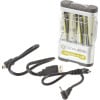OR Show Overview
Another Outdoor Retailer Show has come and gone. At two per year (winter and summer), times 20 years (minus a few missed ones), this was about my 30th OR Show, and I still really enjoy them. More than anything, it is a great way to catch up with all sorts of people, meet new ones and maybe even see some cool gear. The purpose of the show is for gear manufacturers (Black Diamond, Voile, Mountain Hardwear, etc.) to show next year’s gear to gear buyers (REI, Backcountry.com, Martha’s Biners & Bathmats, etc..), but there is usually a lot more looking going on than buying. The buying comes later.
Probably the most asked question in all OR Show history is “Have you seen anything new & cool?” This is kind of a trick question as most of the stuff there is new and cool, but the deeper meaning of the question is more like “Have you seen anything revolutionary?” Most of the time, gear design is evolutionary, which means new colors, sizing or products designed to hit a specific marketing niche. But occassionally, revolutionary new products like plastic teleboots, multitools, portable solar power, hydration systems, shaped skis, camming devices for climbing or portable GPS units come out that change they way people recreate in the outdoors. I didn’t see any such game-changers at this show, but in all fairness, I didn’t look very hard either. Usually, if they are out there, you’ll hear about them.
However, there was some interesting gear that caught my eye…
Pieps Vector – I’ve been a fan of the Pieps DSP transceiver for the last few years and haven’t felt any reason to change until I saw the Pieps Vector. The Vector has all of the great features of the DSP, but also includes GPS and weather data capabilities. If the unit is on, it will track your location, which can then be downloaded onto a computer while the battery is being recharged via a USB port. This is more of a home-based beacon than for expeditions, but it is a nice combination of technologies.
![]()
Mountain Hardwear Chute Packs – I’m admittedly partial to these packs as I helped design them. Available in two sizes, a 28 liter and a 15 liter, they are dedicated ski touring packs. The Chuter 15 is for lightweight day tours or mechanized skiing, and the Chuter 28 is for longer outings, guiding or anywhere you might need to carry more stuff.
Voile Vector Skis – A moderately wide (92-96mm), versatile backcountry ski with rockered tips and a fishscale pattern embedded into the base which allows you to climb up mellow slopes without skins. If you do need skins, you can still slap them on. These would be perfect for “farming” powder laps, but you could also easily take them anywhere else.
ABS Packs – There isn’t much new with the actual guts of the ABS airbag backpack system, but ABS has added a few new styles of “bags” and buffed out their existing design. Unlike other airbag backpacks, the ABS has a “frame” which different sized “bags” can be zipped on/off of. This also allows other manufactures, like Burton and Arva, to make their own bags which can then be merged onto an ABS frame.

BCA Airbag Packs – These have undergone a much needed facelift for 2012/13. I tried the Float 30 and Float 18 last year, and although the airbag safety aspect was indisputable, as a pack they were lacking. For next year, the bags have been redesigned and look nice.
Splitboards – I don’t know phukall about splitboarding, but it is great to see that those who do are getting faster, lighter and more dialed. Jones Snowboards looked well thought out, and the beautifully crafted Karakorum bindings are a pleasure to behold in all of their CNC’d brilliance.
GoalZero Guide 10 Plus – I bought one of these as a show special and they are techie little units that now come now come with a 10 dongle USB adaptor (not shown in the photo below). The unit can be charged from a solar panel or a computer USB port, and then in turn can charge (or power) a variety of items ranging from camera or cell phones to just about anything else.

Sterling Hollow Block – There is alot more to this little product than meets the eye. It is a sewn loop of tubular aramid fiber which will work well as a runner or for a prusik loop. The advantage of using this for a prusik loop is that the aramid fiber has a very high melting temperature, so if you are using it as a glacier prusik and take a long fall into a crevasse with it, it won’t melt or glaze like regular accessory cord. Then, if you want to use it as a runner, it is good for 14kN. Lightweight, low profile, simple and functional.

As an Industrial Designer (ID) by profession and education, it was interesting to see the explosion of ID in the outdoor industry. In the 1950’s ID was all about fins, steel and streamlined shapes, but the two-thousand-teens are going to be remembered for everything looking like an iPhone. You can almost hear the Sales Directors shouting “I DON’T GIVE A DAMN IF IT IS A CARABINER! MAKE IT LOOK LIKE AN APPLE iPRODUCT!” What kind of apps does this binding run?
________________________________
Help support StraightChuter.com and get charged up with a with a pair of Goal Zero Guide 10 Plus Mobile Kit from Backcountry.com. Click on the photo below…
Category: Gear Reviews










Dongle? I learned a new word today. And it’s fun to say.
Dongle, dongle, dongle…